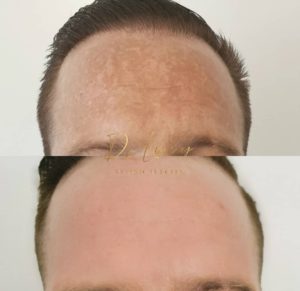Definition of melasma
Melasma is a skin hyperpigmentation, mainly affecting women between 30 and 50 years old on the forehead, cheekbones and upper lip. It is commonly called “pregnancy mask” even though it can appear outside of pregnancy.
The causes are multiple: predisposing genetic factors, sun exposure and estrogenic hormonal changes during pregnancy or contraception.
Hyperpigmentation is the result of many internal and external factors: UV, aging, hormonal changes, photosensitizing treatments. Laser is not an ideal treatment for medium and high skin phototypes (dark skin) because there is a risk of inflammatory hyperpigmentation, unlike Dermamelan®, which is suitable for all skin types.
Principle of the Dermamelan® protocol
Dermamelan is a depigmenting peel that has an intense curative action on skin hyperpigmentation but also a preventive action against recurrence in the long term, thanks to its combination of 3 post-peeling creams, by regulating the synthesis of melanin by the melanocytes.
Dermamelan will accelerate the renewal of the skin by provoking desquamation to eliminate the superficial melanin deposits. Then, the active principles will go down in the deep dermis to have an action on the melanocytes. They will limit the production and migration of melanin from the depth to the surface of the skin. They will also block the transfer of melanosomes (melanin grains) to the upper layers of the skin.
If the results of Dermamelan can be spectacular in the short term for its corrective action, it is essential to maintain the melanocytes under control throughout the year thanks to the use of cosmetics which will be advised to you. The most effective active ingredient is tranexamic acid, which should be combined with sun protection.
DERMAMELAN PROTOCOL (4 PHASES)
PHASE 1
Fifteen days before the Dermamelan peel in the office, it is essential to prepare your skin with a cream containing salicylic acid and phytic acid. These two acids combined will have a keratolytic action in order to remove the superficial layer of the epidermis where the dead cells are located. On the day of the peel, you will come without makeup and Dr. Lucas will use a degreasing solution to remove the sebum from the skin before applying the Dermamelan peel. You will leave with the mask, which you should keep for six to twelve hours depending on medical recommendations. Dr. Lucas will give you a pack containing three cosmetics that will allow you to continue phases 2, 3 and 4 at home. After this break, you can remove the mask with water. During the following days, you will only apply a moisturizing cream to your face. The skin may feel a little tight while being slightly red and dry.
PHASE 2, 3 AND 4
Dr Lucas will give you a pack containing three cosmetics. This pack contains a cream called “Dermamelan”, a soothing balm called “Melan recovery” and a photoprotection called “Melan 130+ pigment control”. You will be asked to use only these three products. Each of these three phases will last one month. The second phase is designed to continue depigmentation, the third to regulate melanogenesis and the fourth to prevent melasma from reappearing. The dosage of these three cosmetics will differ for each phase and will be specified during the interview.
MAINTENANCE
To maintain the results obtained, the melanocytes must be kept “asleep” so that they no longer produce melanin. A photoprotection covering UVA, UVB and blue light must be used daily all year round. Tranexamic acid in serum will block melanogenesis.
Results:
Time frame final results: After a period of 2-3 days with discrete redness and dryness of the skin, we can start to see a depigmenting effect at 4-6 weeks, but to see a significant effect we must wait 6-8 weeks.
Longevity of results: 1 to 2 years
Before the procedure:
Stop smoking at least 4 weeks before treatment (smoking decreases tissue micro-vascularization and compromises healing and collagen creation)
Inform Dr. Lucas of any anticoagulant medication (Aspirin, Sintrom, Coumadin, Eliquis, etc.) in order to arrange for its discontinuation or replacement.
Avoid intense exposure to the sun or laser sessions the month before the peel
Preparation 15 days before the peeling with a combination of creams composed of fruit acids, thus preparing the skin for the peeling.
The ideal time for a peel is from September to April, when the sun is less intense.
Contraindications (strict and relative):
Pregnancy, breastfeeding, history of hypertrophic or keloid scars, anticoagulant treatment, recent intense sun exposure (< 1 month), recent Roaccutane treatment (< 1 year), photosensitizing drug treatment
Procedure:
Pain: no pain during the peeling
Duration of procedure: 45 minutes
Anesthesia : cream
Location: office
Outpatient (without hospitalization)
After the procedure :
Post-peeling pain: no pain, sometimes discomfort including itching that can be relieved with water spray and moisturizer
Social eviction: skin remains pink for a few days
Return to work: 1-3 days
Return to sport: 3 days
Follow-up :
Rinse the mask with warm water without rubbing 6 to 12 hours after its application (6h for white skin, 12 h for black skin).
You can spray with thermal water several times a day to limit the feeling of tightness and moisturize several times a day with Vaseline for 24 to 48 hours.
Then, you can start phase 2 of the treatment 48 hours after the peeling, with the creams that will be provided to you. The precise protocol will be given to you by Dr Lucas.
Dr. Lucas’ control 3 weeks, 6 weeks, 3 months, 6 months.














